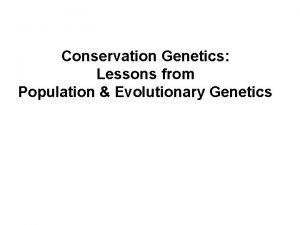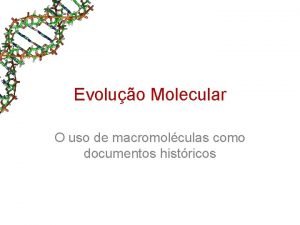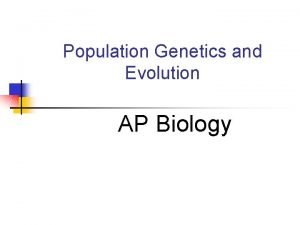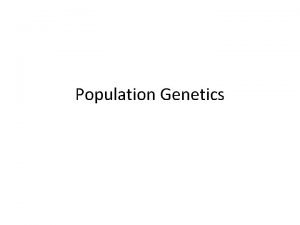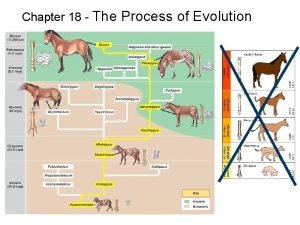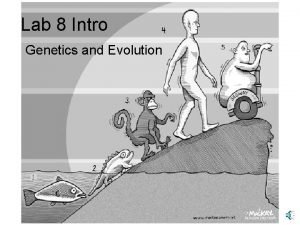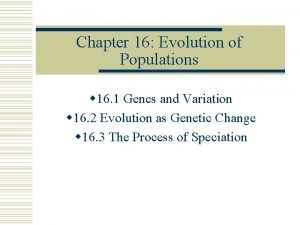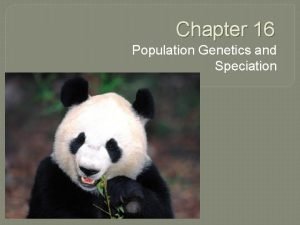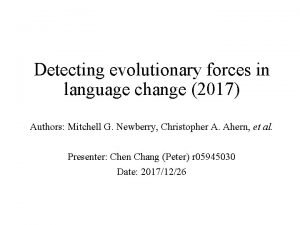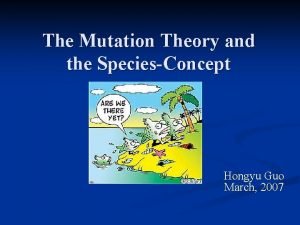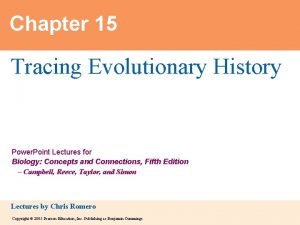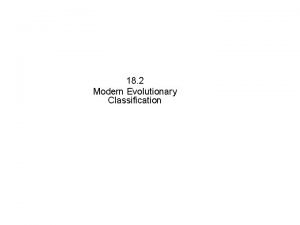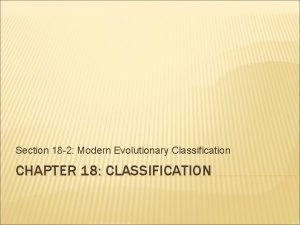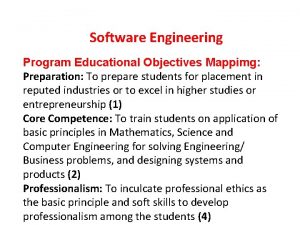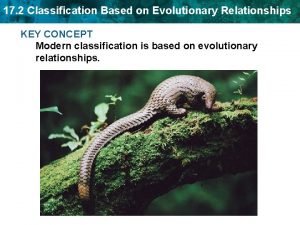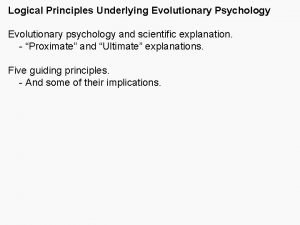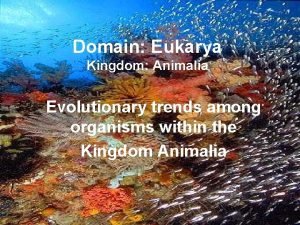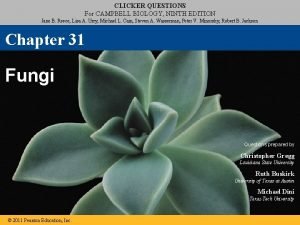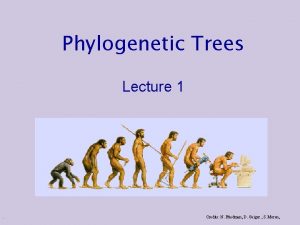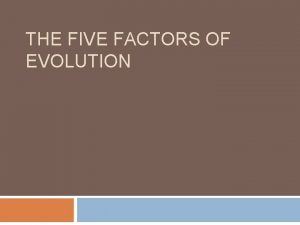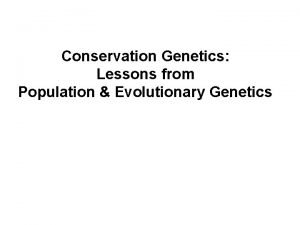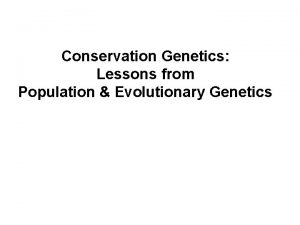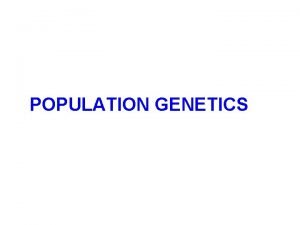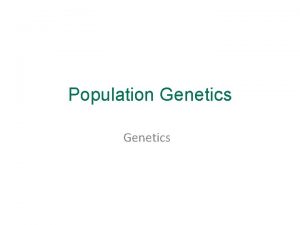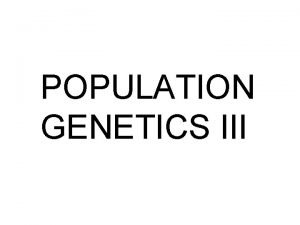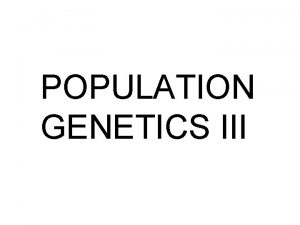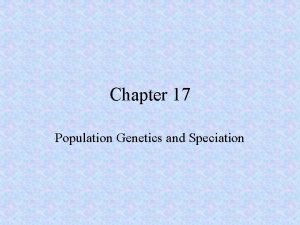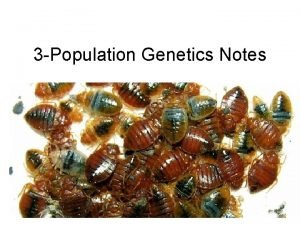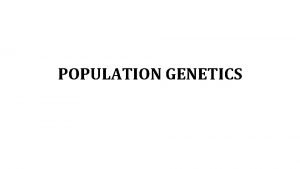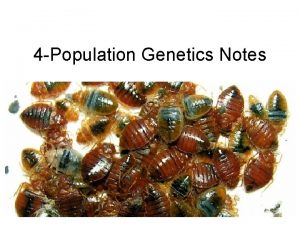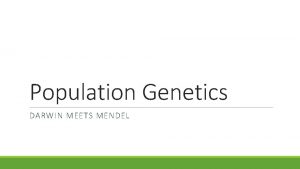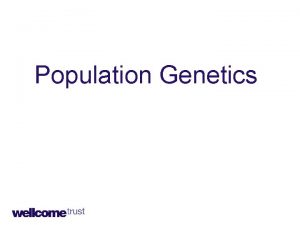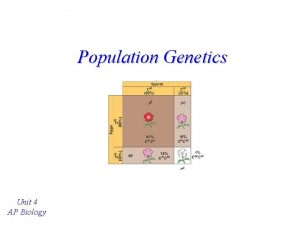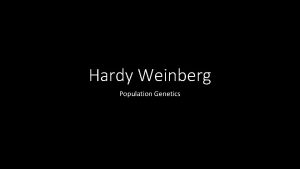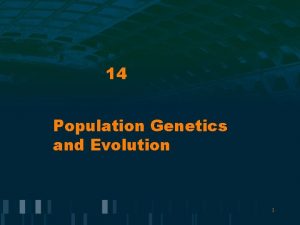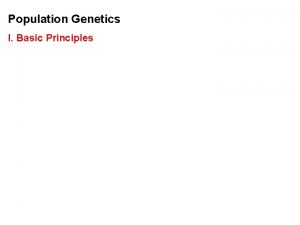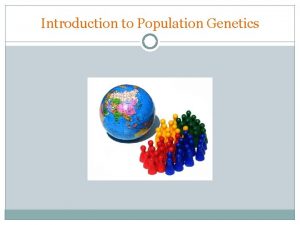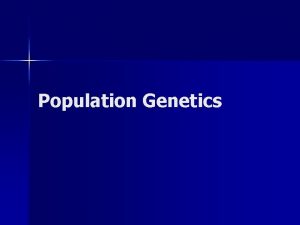Conservation Genetics Lessons from Population Evolutionary Genetics I

































- Slides: 33

Conservation Genetics: Lessons from Population & Evolutionary Genetics

I. Definition Conservation Genetics: The science of understanding how genetic issues affect the conservation and restoration of populations and species.

II. Major Issues (from Frankham 1995) -Inbreeding depression -Accumulation of deleterious alleles small -Loss of genetic variance in small populations population -Genetic adaptation to captivity and effect on size reintroduction success -Fragmentation of populations -Taxonomic uncertainty (unique? , novel? , hybridize for successful reintroduction? )

III. Taxonomic Uncertainty Example: Dusky Sea Side Sparrow (Ammodramus maritimus nigrescens) Avise and Nelson 1989

IV. Small Population Size -Most threatened/endangered species exist in Small Isolated Populations Gaston et al. 1997 (ECOGRAPHY) Newton 1997 (ECOGRAPHY) Must focus on consequences of small population size

Genetic Consequences of Small Population Size: -Loss of Genetic Variation -Inbreeding Depression -Accumulation of Mutations All as a result of Drift and Fragmentation

V. Drift History: Natural historians, including Darwin, noted that some variation among individuals would not result in differences in survivorship and reproduction

e. g. , Gulick, Hawaiian land snails exhibited great diversity of shell color patterns

Changes in pattern across generations arises by chance àDrift (population genetic translation- Wright): Evolutionary process by which allele frequencies change by accidents of sampling

VI. Origin of Accidents of Sampling Assume diploid population with 2 alleles at a locus A with frequency p a with frequency q Zygote = union of 2 independent gametes or union of 2 independent events Thus genotype frequencies represent binomial probability distribution: (p + q)2 or AA= p 2, Aa = 2 pq, aa = q 2

Assume: finite population size (N) Zygotes are a sample of gametes: A or a with frequency p and q Thus random sampling process will introduce variation of allele frequencies across gernation of Variance of binomial: pq/N Diploid organisms: pq/2 N Loss of Heterozygosity is proportional to 1/2 N or 1/2 Ne (Population Geneticists use Ne because loss of heterozygosity is often greater than the census number)

Effect of sampling variation after many generations Change in allele frequencey of Drosophila melanogaster populations

VII. Consequences of Drift: -allele frequencies fluctuate randomly -populations vary by chance -increase variation among populations -decreased heterozygosity in populations -increased homozygosity in populations -increased genetic relatedness in population -SELECTION NOT AS EFFICIENT N e. S < ¼ then deleterious alleles and new deleterious mutations will become fixed by drift (more later)

VII. Consequences of Fragmentation A. Wahlund Effect: All of the same consequences as Drift decreases heterozygosity within populations increases homozygosity within populations increases genetic relatedness within populations

Natural History Examples of Fragmentation (From Hamrick and Godt) # of P species (within population) pollen dispersal animal wind seed dispersal gravity wind 164 102 199 105 36 50 30 43 Gst (among pop) 0. 2 0. 1 0. 3 0. 1 P = % of loci with > 2 alleles Gst = proportion of genetic variation distributed among pop. FRAGMENTATION LOSS OF GENETIC DIVERSITY WITHIN POPULATIONS

B. Further consequences of Fragmentation Allee Effect: As density decreases, ability to find mates also decreases e. g. Oostemeiger, Arnica montana, Netherlands Visitation rates in small and large populations: Small Large High Density Large Low Density

IX. Consequences of Inbreeding A. Inbreeding depression



Low High Heterozygosity Low Extinction Rate High

B. Loss of Genetic Variation Lakeside Daisey (hymenoxys acaulis var. glabra) M. Demauro, 1994 Last remaining population in Illinois Lakeside Daisey is Self Incompatible

Number of Mating Groups

Selection of D. melanogaster for resistance to ethanol fumes in Large vs. Small populations Resistance (minutes) Weber, 1992 L = Large S = Small Generation Consider response to global climate change!

C. Mutation Accumulation Ne. S < ¼ 1. Fixation of ancestral mutations (From Lynch and Burger, 1995)

2. Introduction of new mutations

3. Extinction Risks Due to Mutational Meltdown R = Reproductive Rate; K = Carrying Capacity

Consequences of Mutations for Small Populations Critically Depend on: Mutation Rate Distribution of Mutation Effects (all deleterious? )

X. Genetic Manipulation to Counteract Small Population Size A. Purging of “bad” mutations Husband Schemske, 1996 Natural History Examples:

Drift led to both the fixation and extinction of deleterious alleles

Purging critically depends on genetic basis of inbreeding depression: Inbreeding depression: expression of recessive deleterious alleles in homozygous condition Dudash and Carr, 1998 Inbreeding depression due to recessive alleles

B. Crossing Programs to Restore Genetic Variability Case Study: Fenster and Colleagues Chamaecrista fasciculata


XI. Conclusion Small population size may lead to lower genetic fitness through fixation of deleterious alleles XII. Future Directions We Need: -Better estimates of mutation rates and effects -Field based experiments to determine if a population can be purged of deleterious mutations -Studies to quantify effect of adaptation to captivity -Better understanding of the genetic basis of adaptive differentiation
 Evolutionary genetics
Evolutionary genetics Molecular evolutionary genetics analysis download
Molecular evolutionary genetics analysis download Arvore filogenetica
Arvore filogenetica Population genetics definition
Population genetics definition Modern synthesis
Modern synthesis What is fst
What is fst The far side comics
The far side comics Genetics
Genetics Population genetics
Population genetics Population genetics and speciation worksheet answer key
Population genetics and speciation worksheet answer key Population ecology section 1 population dynamics
Population ecology section 1 population dynamics Chapter test a chapter 4 population ecology answer key
Chapter test a chapter 4 population ecology answer key Population ecology section 1 population dynamics
Population ecology section 1 population dynamics Population ecology section 1 population dynamics
Population ecology section 1 population dynamics Detecting evolutionary forces in language change
Detecting evolutionary forces in language change Modern evolutionary synthesis
Modern evolutionary synthesis Chapter 15 tracing evolutionary history
Chapter 15 tracing evolutionary history 5 fingers of evolution
5 fingers of evolution Evolutionary theory of motivation
Evolutionary theory of motivation 18-2 modern evolutionary classification
18-2 modern evolutionary classification Conventional and evolutionary work breakdown structure
Conventional and evolutionary work breakdown structure Stages of religion
Stages of religion Section 18-2 modern evolutionary
Section 18-2 modern evolutionary Mappimg
Mappimg Perbedaan (planning mode) dan (evolutionary mode)
Perbedaan (planning mode) dan (evolutionary mode) Based on evolutionary relationships
Based on evolutionary relationships Evolutionary psychology questions
Evolutionary psychology questions Chapter 15 darwin's theory of evolution
Chapter 15 darwin's theory of evolution Evolutionary trends in animal kingdom
Evolutionary trends in animal kingdom Clicker fungus
Clicker fungus Evolutionary tree of primates
Evolutionary tree of primates Evolutionary theory of motivation
Evolutionary theory of motivation Class of 20
Class of 20 The five factors of evolution
The five factors of evolution
